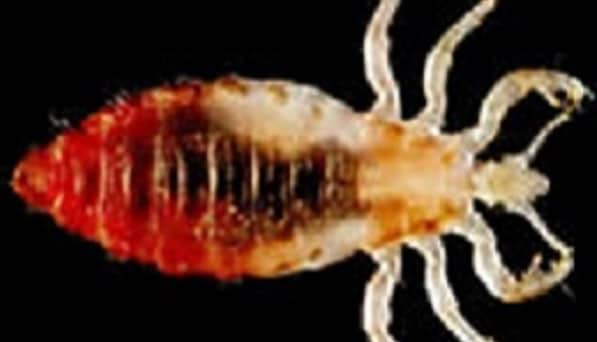Key points
- Body lice are parasitic insects that feed on human blood.
- Body lice spread by direct contact with others who have them.
- Symptoms include itching, rash, and bites.
- The only treatment is to improve hygiene and access to clean clothes.

Overview
Body lice are parasites, or insects, that feed on human blood. Body lice can spread disease. They live and lay eggs on clothing and bedding used by infested people. Adult body lice are small, only 2.3 – 3.6 mm in length (about the size of a sesame seed).
Improved hygiene and access to regular changes of clean clothes is the only treatment needed for body lice infestations; however, in some cases pediculicides are recommended. Body lice can spread disease (epidemic typhus, Bartonella quintana infection, and epidemic relapsing fever).
Symptoms
Intense itching (pruritus) and rash caused by an allergic reaction to louse bites are common symptoms of body lice infestation. As with other lice infestations, intense itching leads to scratching which can cause sores and secondary bacterial infection of the skin.
When body lice infestation lasts long, heavily bitten areas of the skin can become thickened and darkened, particularly in the mid-section of the body (waist, groin, upper thighs).
Who is at risk
Body lice exist worldwide but usually affect people who live in crowded conditions. They affect people without access to regular bathing and clean clothes. They can spread quickly in:
- People experiencing homelessness
- Refugees
- Survivors of war or natural disasters
How it spreads
Body lice spread through direct contact with a person who has body lice. They can also spread through contact with clothing, beds, or linens that have been in contact with a person infested with lice. However, in the United States, actual infestation with body lice tends to occur only in people who do not have access to housing, regular bathing, or clean clothes.
Nits (lice eggs) take 6 – 9 days to hatch. Nits are tiny (0.8 – 0.3 mm) and hard to see; they can be confused for dandruff. Nymphs (newly hatched lice) are about the size of a pinhead and take about a week to grow into adults. Adult lice are about the size of a sesame seed, have six legs, and are tan to grayish white. Adult females can lay up to eight nits per day. Adult lice need to feed on blood several times each day; without blood meals, the louse will die within 1 – 2 days off the host.
Dogs, cats, and other pets do not spread human lice.
Prevention
Take these steps to help prevent and control the spread of body lice:
- Bathe regularly and change into machine-washed clothes at least once a week.
- Machine wash and dry infested clothing and bedding using the hot water (at least 130°F) laundry cycle and the high heat drying cycle.
- Dry clean clothing and items that are not washable OR seal them in a plastic bag and store for two weeks.
- Do not share clothing, beds, bedding, or towels used by a person infested with body lice.
- You can fumigate or dust with chemical insecticides to control and prevent the spread of body lice for certain diseases (e.g., epidemic typhus).
Diagnosis
You can diagnose body lice infestation by finding eggs and crawling lice in the seams of clothing. Sometimes you can see a body louse crawling or feeding on the skin.
Although body lice and nits can be large enough to see with the naked eye, a magnifying lens may help to find crawling lice or eggs.
See a healthcare provider if you are unsure about an infestation.
Treatment and recovery
You can treat a body lice infestation by improving personal hygiene. Bathe and change into clean clothes at least once a week. Wash clothing, bedding, and towels used by the person infested with lice using hot water (at least 130°F) and machine dry using the hot cycle.
Pediculicide, a medicine that can kill lice, is sometimes used for treatment. If prescribed a pediculicide, apply it exactly as directed on the bottle or by your healthcare provider. However, a pediculicide is generally not necessary if hygiene is maintained and items are machine washed appropriately at least once a week.
